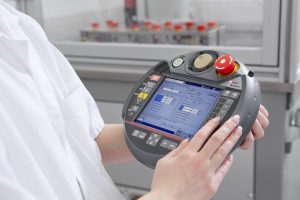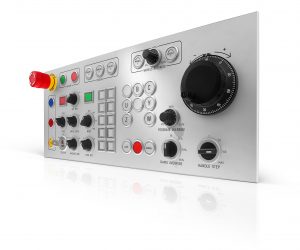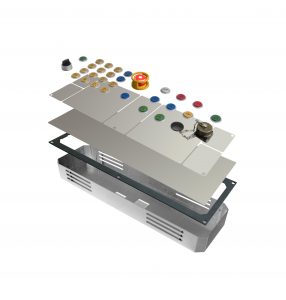
What are human machine interfaces and how do they work?
By EAO AG
Automation / Robotics Circuit Protection Engineering Supply Chain HMI human machine interfacesHuman Machine Interface by definition encompasses all the elements a person will touch, see, hear, or use to interact with a machine. When it comes to human interface technology, advancements are rapidly evolving.
HMI Components are often considered switches and can consist of individual devices such as pushbuttons, emergency stops, keylocks, indicators and more. For basic switch understanding, technology drives the energy through the switch to a conductor, which can make or break an electrical current through a system. A basic switch in a single circuit system is said to have one pole representing the amount of circuits that can be activated through this switch. Switches can have normally open contacts, normally closed contacts, or a combination of both. In order to create ultimate performance, switches have evolved to using gold and silver contacts that are suitable for various power levels and applications requirements.

Changing the contacts however, soon caused other problems such as arcing, welding, and bounces. Using modern technology, switch designers are finding ways to reduce these issues by focusing on how making or breaking contacts occurs. To minimize bounce, engineers are reducing the amount of kinetic energy of the contact by adding buffer springs, air, or oil shock absorbers to dampen contact recoil. As for arcing, snap-action switching elements reduce it by rapidly moving contacts from one spring-loaded position to another independent of actuator speed. On the other hand, slow make/break switching elements, usually used in emergency-stop switches and in high- power applications, employ rigid contact arms that force necessary contact separation to overcome contact welding.
Many switches today are modular, comprised of quickly assembled components including actuators, switching elements, illumination blocks, lenses, marking plates, and mounting systems.
The actuator assembly, including the front-lens touch surface, is the part of a switch that directly interacts with a user. They are designed to require a specific level of force to affect switching action. Tactile feel is a subtle feature that makes the actuator simple to control. It provides an indication – sensed by human touch – that the point has been reached where slight additional pressure will activate the switch. For touch-sensitive switches, capacitive, high frequency, or Piezo technology is used rather than mechanical actuators to sense when they have been touched and initiate a response, such as turning on lights or opening passenger doors on mass transit vehicles.
Another important aspect of modern day switches is environmental sealing. The type and amount of environmental sealing needed for a switch depends on where it is located. Switches operated in clean, indoor environments do not need protected switchgear. For industrial, transportation, indoor/outdoor public access, and lifting/ moving environments rugged oil-and water-tight switches are needed. And in certain hazardous conditions, explosion-proof enclosures are needed as well.
Another area one will see major technological change is in the use of light emitting diodes (LEDs) in illumination. While LEDs cost more, they can last ten times longer and consume half the power of an incandescent bulb, and excel in applications requiring frequent on-off cycling that may cause incandescent bulbs to fail faster. For colored illumination, switches with multiple lenses or Red, Green and Blue (RGB) LEDs can provide more information by using different colors to indicate specific switch states. Truly intuitive designs can be achieved by synthesizing or blending colors utilizing PWM (Pulse- Width Modulation) techniques, which give the ability to create any color in the spectrum.
Overall, today’s advanced HMI Components are precisely crafted devices, made adhere to specific design specifications and very close tolerances from high-grade plastics, metals, and carefully calibrated springs.
The task of an HMI System is to make the function of a technology self-evident to the user. A well-designed ‘mixed technology’ HMI fits the user’s image of the task he or she will perform. The effectiveness of the HMI can affect the acceptance of the entire system; in fact in many applications it can impact the overall success or failure of a product. The HMI System is judged by its usability, which includes how easy it is to learn as well as how productive the user can be. An HMI System performs the functions that the user requires to carry out the prescribed task with a minimum of expended effort while improving productivity. Finally, it needs to perform to the user’s satisfaction. It is the task of everyone involved in the HMI design, the engineers, management, HMI consultant, and industrial designer, to meet the defined usability requirements for a specific HMI System.
A well-designed HMI System does more than just present control functions and information; it provides an operator with active functions to perform, feedback on the results of those actions, and information on the system’s performance.
• What Services and Benefits to the Customer do Human Machine Interfaces Provide?
The interactive impact of the human/machine interface is much more significant than its basic functionality. HMI is the principal point of contact between the user and a machine or process. A good implementation of HMI design practice makes this interaction seem intuitive. Poor HMI design can alienate users or potential customers, encourage users to circumnavigate the system, or result in poor or unsafe system performance. As the direct link to the user, HMIs directly represent the core system’s quality and value.
For HMI Components, this new technology has allowed for easy customization, a range of different switching configurations, and long-term reliable switches. With great flexibility of switch designs, it is possible to create switches with different lens colors, materials, shapes, colors, and actuator functions, making it easy-to -use for all industries.
A well-designed HMI System does more than just present control functions and information; it provides an operator with active functions to perform, feedback on the results of those actions, and information on the system’s performance.
• What is the business model and how do Human Machine Interfaces Affect the Bottom Line?
Selection and implementation of proper HMI can have a critical impact on the use and overall efficiency of equipment.Failure and poor performance can often lead to costly equipment downtime that can negatively affect the bottom line, brand, and frustration of end users.
The business model is creating advanced and carefully crafted HMI components and systems that allow customer supplied solutions to have long, reliable service lives.
The basic concept is – be mindful that the HMI is the user link to all system functions. Failure to consider this can affect the acceptance and usability of the entire machine. A poor HMI System can alienate users or potential customers and encourage users to circumnavigate the system.
• What is the implication of Human Machine Interfaces to each industry segment and industry if applicable?
HMI design and ‘mixed technology’ implementation practices have implications specifically for the following industries. Meeting industry best practices is important in placement of components, large surface area, legend size and color, emergency stop switch configuration, protection guards and shields, and other ergonomic factors.
* Industrial industry: With today’s focus on space saving solutions, HMI systems incorporate sophisticated human interface design and space utilization. User-friendly panel design using advanced switch technology combine to deliver greater industrial system uptime and productivity.
* Transportation industry: As transportation systems grow more complex, operator controls and passenger access products should be easier to understand and use in order to reduce the risk of human error. Switches and control panels are used in driver compartments, for passenger doors, emergency controls, operating panels, and passenger communication systems.
* Public Access/Security industry: Vandal resistant and virtually non-destructive keyboards and keypads are used indoor and outdoor for banking terminals, kiosks, parking meters, and access control. Factors such as environmental sealing, product marking and labeling techniques, and the durability of exposed materials are critical in selecting the most optimal choice of HMI.
* Lifting/moving industry: Elevators, forklift trucks, cranes, conveyors, robotics, and special ground support equipment require durable, reliable control systems that function in all environments and resist shock, vibration, and heavy wear.

A key to the entire HMI design cycle is a thorough knowledge of federal, industry, ergonomic, safety, and design standards. These include Human Engineering standards, such as MILSTD- 1472F, which establishes human engineering design criteria for military systems, subsystems, equipment, and facilities; federal standards like those set by the Americans with Disabilities Act; and industry guidelines such as those from SEMI, the global semiconductor industry association, covering HMI for semiconductor manufacturing equipment. Additional HMI specifications are furnished by ANSI, IEEE, ISO, and others.
The effectiveness of HMI selection and design practices depends upon an exacting process that incorporates all technical, ergonomic, and communication requirements. The impact of the human/machine interface is much more significant than its basic functionality.HMI components and systems are the principal point of contact between the user and a machine or process.


